With systematic thinking about the whole supply chain in terms of the life cycle of product, Green Supply Chain (GSC) refers to the best modern management mode for enterprises. It aims at coordinated and general environmental management of the whole supply chain through close cooperation and mutual constraints among each organization and between relevant organizations in the supply chain in order to obtain environmental, economic and social benefits of supply chain with high efficiency of resource and energy, low emissions and good ecology.
Under the background of current global economic integration and global environmental problems, green supply chain as the most direct and effective approach to the pollution of supply chain enterprises gradually enters the horizon. With the driving force of the procurement and consumption of governments, enterprises and the public, green supply chain creates the incentives of market mechanism. With proper mode for management of supply chain, it facilitates enterprises to reduce environmental pollution and raise energy efficiency so as to improve environmental governance efficiency of the whole supply chain and facilitate green upgrading of the whole industrial chain. With application of market force, this innovative environmental management approach has developed a kind of incentive and advocacy measures to encourage relevant enterprises in the supply chain meeting environmental protection standards, improving their environmental performances and meeting low carbon, green and environmental protection targets.
With circular economy as the idea and sustainable development as the target, green supply chain was firstly mentioned by Manufacturing Research Association of Michigan State University in its study on “Environmentally Responsible Manufacture (ERM) in 1996, also called as Environmentally Conscious Supply Chain (ECSC) or Environmentally Supply Chain (ESC). It is a modern management mode with comprehensive consideration of environmental impacts and resource efficiency in the whole supply chain. Based on green manufacturing theory and supply chain management skills, green supply chain involves supplier, manufacturing plant, marketer and user. It aims at minimizing environmental impacts (negative roles) and maximizing resource efficiency of product in the whole processes such as acquisition of materials, fabrication, packaging, warehousing, transport, utilization and dumping.
Green supply chain management focuses on the following areas compared with the management of traditional supply chain:
1. Change of targets. Traditional supply chain aims at reducing cost, improving the efficiency of enterprises in supply chain and achieving maximum economic benefits. Apart from seeking maximum economic benefits of supply chain, green supply chain also seeks optimum ecological benefits and social benefit of supply chain, saves resources and energy, reduces emission of pollutants, improves the efficiency of the entire society in utilization of resources and achieves the balance among economic benefits, social benefits and environmental benefits.
2. Change of the scope of
management of supply chain
Different from the management of traditional supply chain, the management of
green supply chain includes environmental performances in each link of the
management of both internal and external supply. It must integrate the concepts
of low carbon, green and environmental protection into all processes of
logistics and supply chain and develop a complete green supply chain system
with the support of the entire life cycle including product design, procurement
of raw materials, manufacture, consumption and recycling.
3. Change of material flow
Traditional
supply chain originates from suppliers and ends at users. The material flow is in single
direction, irreversible and a kind of “cradle to grave” management. However, green supply chain must achieve the
transformation of this material flow and meet the policy of “from cradle to
cradle”. In green supply chain, material flow is a circular and reversible management of
industrial ecology.
4. Change of environmental
management mode
Environmental management of traditional supply chain
mainly depends on the supervision of government departments. However, the management of
green supply chain makes full use of market mechanism, utilizes mutual promotion and constraint among
enterprises, motivates the initiatives of enterprises, develops market
constraint mechanism, and improves environmental supervision system.
Support of relevant national policies:
The concept on green supply chain has been gradually mainstreamed into relevant national policies over the past few years.
a) Ministry of Finance and State Environmental Protection Administration jointly released the Suggestions on the Implementation of Government Procurement of Environmental Labeling Products and List of Government Procurement of Environmental Labeling Products in 2006;
b) Ministry of Commerce, MEP and Ministry of Industry and Information Technology jointly released the Guidelines for Green Procurement of Enterprises in December of 2014. It plays a leading role in building a resource saving and environment-friendly society; guiding active fulfillment of environmental responsibilities by enterprises; promoting green consumption; achieving green and low carbon development and developing green supply chain.
c) “The China Manufacturing 2025” distributed by the State Council in May of 2015 is the strategy of China for promoting the development of a strong manufacturing country in an all round way. This is the First 10-Year Action Plan of the Implementation of National Strategy of China for the Development of a Strong Manufacturing Country. It defines 9 strategic tasks. The Fifth Task requires comprehensive promotion of green manufacturing — which includes creating green supply chain; accelerating the establishment of the procurement, production, marketing, recycling and logistics system that saves resources and is environment-friendly; and implementing EPR system. It is for the first time that the word “strengthening the development of ecological civilization” is written in the 13th national five-year plan. Chapter 48 “Development of Green and Environmental Industry” of the Plan requires “accelerating the development of green supply chain industrial system”.
d) At the MEP meeting held in January of 2016, Minister Chen Jining pointed out that the “13th Five-Year Plan” period is the decisive phase for the development of Xiaokang (well-off) society in an all round way and meet the First 100-Year Target. The activities in 6 areas for meeting the overall goal of the environmental protection targets of the “13th Five-Year Plan” include the promotion of environmental management of green supply chain.
e) Ministry of Finance, NDRC, Ministry of Industry and Information Technology and MEP developed the Program on the Implementation of Environmental Leader System in 2015. The government will encourage the implementation of environmental management of green supply chain by industrial leaders, which will focus on environment-friendly design of products, apply highly efficient clean production technology, achieve low emissions in the whole life cycle and reach internationally advanced level of clean production.
f) The Guidelines on Giving Play to the Role of Environmental Protection and Promoting the Structural Reform of Supply Side released in April of 2016 by MEP also clearly points out that we should make innovations on environmental policy, pay equal attention to reverse constraints and positive incentives, intensify the internal driving force of market for environmental protection and facilitate the development of resource-saving and environment-friendly industrial system. This includes the selection of the mature products with large amount in production and consumption, great potential in emission reduction, good standards, advanced management of green supply chain and application of environment-friendly technology. The government will organize the implementation of environmental leader system for industrial products and promote environmental management of green supply chain focusing on green production, green procurement and green consumption. China will study and develop policy support measures and standards, promote the production of eco products and green products, and accelerate the development of green supply chain industrial system.
g) The Program on the Implementation of 2016 Special Action on Green Manufacturing (Gongxinbujie No.(2016) 113) printed out and distributed by Ministry of Industry and Information Technology in April of 2016 clearly points out that one of the top priorities of the Guidelines is facilitating the trial work on green manufacturing system, that is, promoting trial work on the development of green manufacturing system and releasing the Guide for the Development of Green Manufacturing Standards, Guidelines for Assessment of Green Factory and the Program on Trial Management of Green supply Chain.
h) The Main Task 6 of the Plan for Green Development of Industry (2016-2020) released by Ministry of Industry and Information Technology on July of 2016 clearly points out that China should establish green supply chain. Based on the leading enterprises of industries such as automobile, electronics, household appliances, communications, machinery and complete set of large equipment with the support of green supply chain standard and EPR system, it will drive the upstream part or element suppliers and downstream recycling enterprises, while ensuring product quality, to meet the responsibility for environmental protection and build resource-saving and environment-friendly green supply chain covering the processes such as procurement, production, marketing, recycling and logistics. China should establish the information system that could trace green raw materials and products.
i) MEP issued the Cooperation Plan for the Protection of the Eco Environment of the “Belt and Road” Countries in May of 2017 in order to strengthen green development of the “Belt and Road” and promote sustainable development and common prosperity. “Promoting sustainable production and consumption and developing green trade” is one of important measures. It includes the establishment of green supply chain management system; trial and demonstration on the management of green supply chain and formulation of policy instruments on environmental management of green supply chain in order to promote green development in terms of the whole industrial chain including production, circulation and consumption. MEP will conduct green certification for each link of green supply chain, promote the assessment of green supply chain performances and explore the possibility of establishing the performance assessment system for green supply chain. MEP will strengthen international cooperation on green supply chain. It will actively facilitate the development of cooperation network of green supply chain; support green production, green procurement and green consumption and promote green supply chain management in international trade. MEP will promote the establishment of demonstration sites for cooperation on green supply chain. In addition, it will enhance the publicity and exchanges of the activities of the “Belt and Road” countries on green supply chain and encourage the release of the initiative on inter-government cooperation on green supply chain. Moreover, it will encourage organizations such as industrial associations and international chamber of commerce to carry out publicity and extension activities.

Figure 1 Relevant projects of CEC on green supply chain
Paying close attention to Chinese and international studies on green supply chain for many years, CEC has carried out activities in areas such as research projects, policy making, standards, assessment of corporate green supply chain, certification of China Environmental Labeling products and formulation of the List of Government Procurement of Environmental Labeling Products.
 In 2008, CEC conducted the
certification on ISO14001 Management System for Beijing
Organization Committee for the Games of the XXIX Olympiad and developed the
Guide for Green Logistics and carried out certification on green decoration of
part of key stadium and venues. The work of CEC was commended by Beijing
Organization Committee of the Olympic Games. In December of 2008, CEC took part
in the work on developing green supply chain criteria for Wal-Mart. CEC and
Wal-Mart (China) Investment Limited Company sign the MOU on Environmental
Sustainability. The two parties decided that they will jointly advocate and
discuss the policies and progress of sustainable development of the environment
at global scale, share experience of the two sides and carry out close
cooperation in areas such as exchange of relevant information on green
supermarket criteria and certification. With the action of supermarket, they
would conduct the management of green supply chain and promote transformation
to sustainable production in upstream suppliers.
In 2008, CEC conducted the
certification on ISO14001 Management System for Beijing
Organization Committee for the Games of the XXIX Olympiad and developed the
Guide for Green Logistics and carried out certification on green decoration of
part of key stadium and venues. The work of CEC was commended by Beijing
Organization Committee of the Olympic Games. In December of 2008, CEC took part
in the work on developing green supply chain criteria for Wal-Mart. CEC and
Wal-Mart (China) Investment Limited Company sign the MOU on Environmental
Sustainability. The two parties decided that they will jointly advocate and
discuss the policies and progress of sustainable development of the environment
at global scale, share experience of the two sides and carry out close
cooperation in areas such as exchange of relevant information on green
supermarket criteria and certification. With the action of supermarket, they
would conduct the management of green supply chain and promote transformation
to sustainable production in upstream suppliers.
 In 2010, CEC took part in CCICED
Policy Research on Practice and Innovation on Green Supply Chain. With
investigations and analysis on green supply chain at government and enterprise
levels in China, the Task Force identifies existing problems of China on green
supply chain and presents solutions. With these as the bases, Tianjin and
Shanghai have actively conducted trial work on green supply chain.
In 2010, CEC took part in CCICED
Policy Research on Practice and Innovation on Green Supply Chain. With
investigations and analysis on green supply chain at government and enterprise
levels in China, the Task Force identifies existing problems of China on green
supply chain and presents solutions. With these as the bases, Tianjin and
Shanghai have actively conducted trial work on green supply chain.
 Entrusted by US APPLE Company, CEC carried out environmental audit
on 13 upstream suppliers in the mainland of China in 2012, mainly including the
operation of environmental management system of suppliers and identification of
important environmental factors for enterprises, waste management, wastewater
management, emission management, water management, energy & GHG management,
land use and biodiversity, noise management, management of hazardous substances/prevention and control of soil and
groundwater pollution. The CEC report comprehensively describes relevant
information of suppliers of APPLE
about environmental compliance, greatly avoids possible environmental risk to APPLE
Company and establishes a green brand for APPLE. The findings of this environmental
audit are quoted by APPPL Company in its Report on Corporate Social
Responsibility published in the world.
Entrusted by US APPLE Company, CEC carried out environmental audit
on 13 upstream suppliers in the mainland of China in 2012, mainly including the
operation of environmental management system of suppliers and identification of
important environmental factors for enterprises, waste management, wastewater
management, emission management, water management, energy & GHG management,
land use and biodiversity, noise management, management of hazardous substances/prevention and control of soil and
groundwater pollution. The CEC report comprehensively describes relevant
information of suppliers of APPLE
about environmental compliance, greatly avoids possible environmental risk to APPLE
Company and establishes a green brand for APPLE. The findings of this environmental
audit are quoted by APPPL Company in its Report on Corporate Social
Responsibility published in the world.
 The Demonstration Project on the
Management of Green Supply Chain in Shanghai began in January of 2013. Shanghai
Municipal Environmental Protection Bureau cooperated with US Environmental
Defense Fund to facilitate the trial and extension activities on the management
of green supply chain in Shanghai. As the third party professional institution
of the project, CEC provided technical support to the enterprises participating
in the demonstration project on the management of green supply chain in
Shanghai.
The Demonstration Project on the
Management of Green Supply Chain in Shanghai began in January of 2013. Shanghai
Municipal Environmental Protection Bureau cooperated with US Environmental
Defense Fund to facilitate the trial and extension activities on the management
of green supply chain in Shanghai. As the third party professional institution
of the project, CEC provided technical support to the enterprises participating
in the demonstration project on the management of green supply chain in
Shanghai.
 The 26th APEC Ministers
Meeting approved the
establishment of APEC Green Supply Chain in
November of 2014 and established the first demonstration center in Tianjin. Based
on the experience and advantages in areas such as development and
interpretation of standards as well as certification over the past years, CEC
has provided technical support to Tianjin in terms of establishing the
framework and development of relevant criteria for green supply chain. Among
them, Tianjin standards for green supply chain such as Green Supply Chain
Management System — Requirements (DB12/T 632-2016) and Green Supply
Chain Management System — Implementation
Guide (DB12/T 662-2016) developed by CEC have been
officially published and implemented.
The 26th APEC Ministers
Meeting approved the
establishment of APEC Green Supply Chain in
November of 2014 and established the first demonstration center in Tianjin. Based
on the experience and advantages in areas such as development and
interpretation of standards as well as certification over the past years, CEC
has provided technical support to Tianjin in terms of establishing the
framework and development of relevant criteria for green supply chain. Among
them, Tianjin standards for green supply chain such as Green Supply Chain
Management System — Requirements (DB12/T 632-2016) and Green Supply
Chain Management System — Implementation
Guide (DB12/T 662-2016) developed by CEC have been
officially published and implemented.
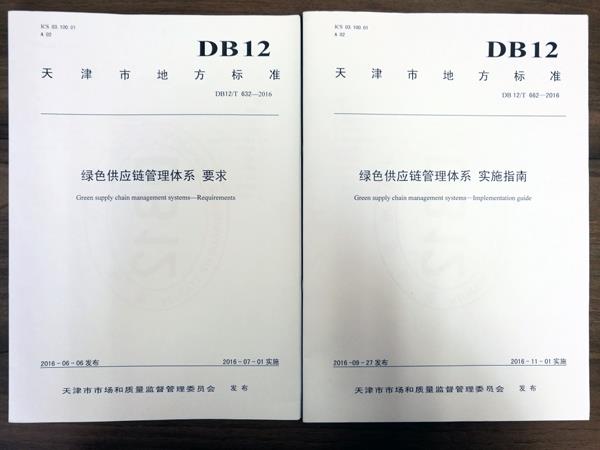
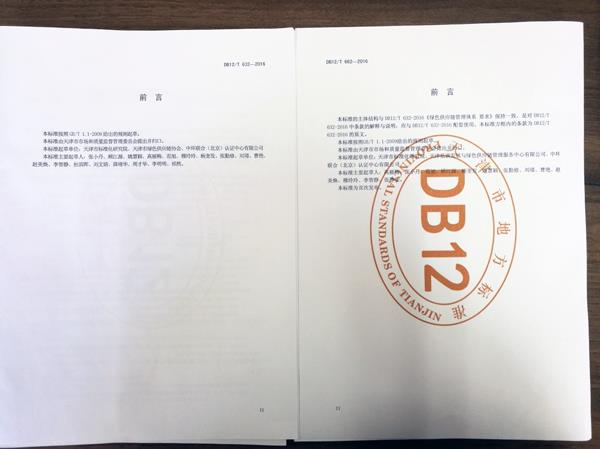
Figure 2 Tianjin Standard for Green Supply Chain developed by CEC
 On December 17, 2015, MEP officially approved the trial work on the
management of green supply chain in Dongguan with the Letter on Supporting
Trial Work on Environmental Management of Green Supply Chain in Dongguan City.
CEC, China-ASEAN Environmental Cooperation Center and Environmental Defense
Fund Office of Project in China conducted a cooperation project to promote
environmental management of green supply chain of Dongguan City based on
industrial characteristics and environmental requirements of Dongguan City. As
one of technical support organizations for the “Trial on the Management of
Green Supply Chain in Dongguan”, CEC has taken part in the study and
identification of the “Dongguan Index” for the green supply chain of Dongguan.
It has participated the development of the documents such as Program of
Dongguan on Trial of Green Supply Chain, Assessment Guidelines for Green Supply
Chain Management—— Green Supply Chain Dongguan Indicators (Trial) and drafted
the Guidelines of Dongguan for Green Supply Chain Management. It was in charge
of implementing the Trial Assessment of the Management of Green Supply Chain of
Furniture/Shoe-making Industries of Dongguan in trial enterprises of the city.
CEC has finished the Report on Trial Assessment of Green Supply Chain
Management Indicators of Dongguan. Up
to now, CEC has completed the assessment of green supply chain of 28
enterprises in two industries such as shoe-making and furniture.
On December 17, 2015, MEP officially approved the trial work on the
management of green supply chain in Dongguan with the Letter on Supporting
Trial Work on Environmental Management of Green Supply Chain in Dongguan City.
CEC, China-ASEAN Environmental Cooperation Center and Environmental Defense
Fund Office of Project in China conducted a cooperation project to promote
environmental management of green supply chain of Dongguan City based on
industrial characteristics and environmental requirements of Dongguan City. As
one of technical support organizations for the “Trial on the Management of
Green Supply Chain in Dongguan”, CEC has taken part in the study and
identification of the “Dongguan Index” for the green supply chain of Dongguan.
It has participated the development of the documents such as Program of
Dongguan on Trial of Green Supply Chain, Assessment Guidelines for Green Supply
Chain Management—— Green Supply Chain Dongguan Indicators (Trial) and drafted
the Guidelines of Dongguan for Green Supply Chain Management. It was in charge
of implementing the Trial Assessment of the Management of Green Supply Chain of
Furniture/Shoe-making Industries of Dongguan in trial enterprises of the city.
CEC has finished the Report on Trial Assessment of Green Supply Chain
Management Indicators of Dongguan. Up
to now, CEC has completed the assessment of green supply chain of 28
enterprises in two industries such as shoe-making and furniture.
 In 2016,
CEC with top
level design had developed a series of technical standards such as Technical
Standard for Green Supply Chain Management System, External Supplier Assessment
Guideline for Green Supply Chain, Green Grade Assessment Standard for Green
Supply Chain Organizations and Performances Evaluation Guideline for Green
Supply Chain and submitted them to Certification and Accreditation
Administration for file covering areas such as system development, assessment
of supply side, assessment of greenness and assessment of performances based on
the experience in effective implementation of international management system
such as ISO14001 and ISO9001 as well as
operational model. They provide technical support to the enterprise with the
requirements for the development of relevant system for the management of green
supply chain. UNEP 10 Year Framework Plan for
Sustainable Public Procurement (SPP
10YFP” presents a special report on it.
In 2016,
CEC with top
level design had developed a series of technical standards such as Technical
Standard for Green Supply Chain Management System, External Supplier Assessment
Guideline for Green Supply Chain, Green Grade Assessment Standard for Green
Supply Chain Organizations and Performances Evaluation Guideline for Green
Supply Chain and submitted them to Certification and Accreditation
Administration for file covering areas such as system development, assessment
of supply side, assessment of greenness and assessment of performances based on
the experience in effective implementation of international management system
such as ISO14001 and ISO9001 as well as
operational model. They provide technical support to the enterprise with the
requirements for the development of relevant system for the management of green
supply chain. UNEP 10 Year Framework Plan for
Sustainable Public Procurement (SPP
10YFP” presents a special report on it.
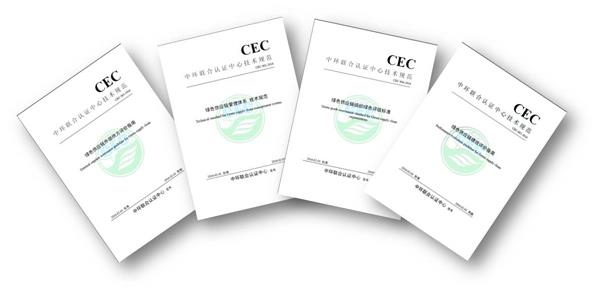
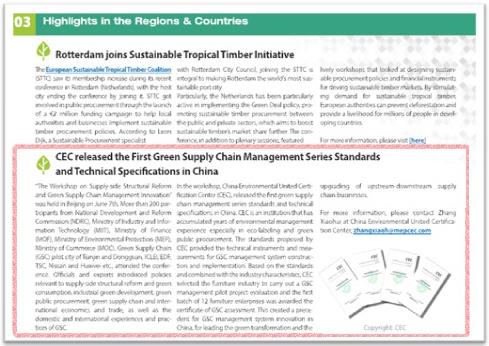
Figure 3 UNEP report on CEC Technical Standards on Green Supply Chain
 In addition, CEC has
released two sector technical standards “Technical Standard for Assessment of
Green Supply Chain ─ Furniture” and “Technical Standard for Assessment of Green
Supply Chain ─ Copying Machine, Printer, Fax and Multifunction Printer” and
assessed the work of enterprises on green supply in line with the above technical
standards.
In addition, CEC has
released two sector technical standards “Technical Standard for Assessment of
Green Supply Chain ─ Furniture” and “Technical Standard for Assessment of Green
Supply Chain ─ Copying Machine, Printer, Fax and Multifunction Printer” and
assessed the work of enterprises on green supply in line with the above technical
standards.
 In 2016, CEC developed the Technical Specifications for
Assessment of Green Supply Chain for typical industries such as furniture and electronic
products based on the above system and documents and submitted them to Certification
and Accreditation Administration for file. CEC has carried out the assessment
of green supply chain of 19 enterprises across the country with the above
technical specifications as technical bases. On October 7, 2016, the Nihon Keizai Shimbun with the title “Certificate granted by the most authoritative
environmental certification agency of China” and Nikkan Kogyo
Shimbun with the article “The First
Japanese Enterprises Winning Five-Stars Grade” reported the news that Canon Inc. wins CEC Five-Stars
Certificate for Green Supply Chain and the “Award of Excellent Enterprises with China Environmental
Label”.
In 2016, CEC developed the Technical Specifications for
Assessment of Green Supply Chain for typical industries such as furniture and electronic
products based on the above system and documents and submitted them to Certification
and Accreditation Administration for file. CEC has carried out the assessment
of green supply chain of 19 enterprises across the country with the above
technical specifications as technical bases. On October 7, 2016, the Nihon Keizai Shimbun with the title “Certificate granted by the most authoritative
environmental certification agency of China” and Nikkan Kogyo
Shimbun with the article “The First
Japanese Enterprises Winning Five-Stars Grade” reported the news that Canon Inc. wins CEC Five-Stars
Certificate for Green Supply Chain and the “Award of Excellent Enterprises with China Environmental
Label”.
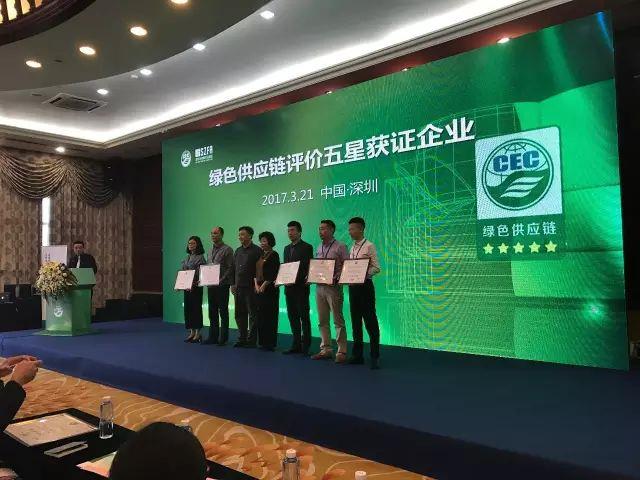

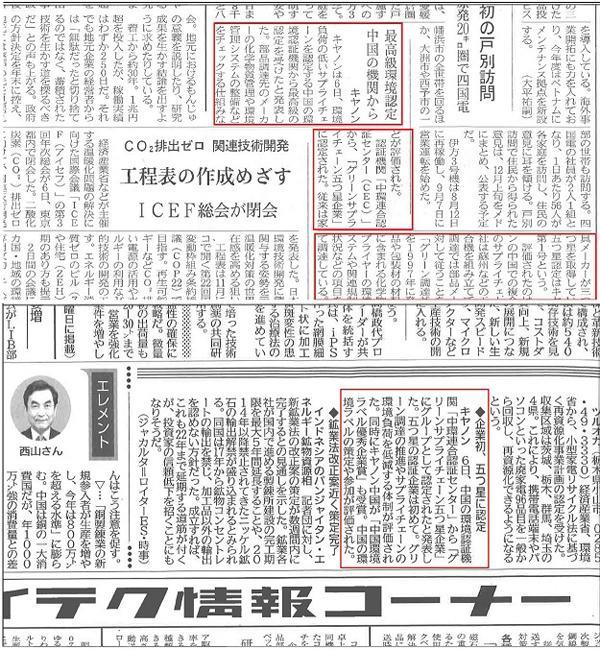
Figure 4 Reports of Japanese newspaper on Canon Inc. winning the CEC Certificate of Green Supply Chain
 In 2015, CEC finished the early study for the key research
project of MEP
Environmental Development Center with the title “Study on the Impacts of Guidelines for Assessment of the
Policies and Techniques on Green Supply Chain on the Management of Supply China”.
In 2015, CEC finished the early study for the key research
project of MEP
Environmental Development Center with the title “Study on the Impacts of Guidelines for Assessment of the
Policies and Techniques on Green Supply Chain on the Management of Supply China”.
 In 2016, CEC took part in the “Study
Project on the Development of an Environment-Friendly Country” as a cooperation
project with JICA. They would joint study on green supply chain in China and
Japan.
In 2016, CEC took part in the “Study
Project on the Development of an Environment-Friendly Country” as a cooperation
project with JICA. They would joint study on green supply chain in China and
Japan.
 The on-going research and application
project on the development of common technologies for quality with the title “Research and Application of Key Techniques for Assessment
of Intelligent and Green Manufacturing Certification”, which is included in the National Plan for Key Research
and Development Projects.
The on-going research and application
project on the development of common technologies for quality with the title “Research and Application of Key Techniques for Assessment
of Intelligent and Green Manufacturing Certification”, which is included in the National Plan for Key Research
and Development Projects.
 The on-going early study for the
key research project “Study on the
Guidelines for Technical Assessment of Green Supply Chain and Detailed
Implementation Rules for Typical Industries” of MEP Environmental Development Center.
The on-going early study for the
key research project “Study on the
Guidelines for Technical Assessment of Green Supply Chain and Detailed
Implementation Rules for Typical Industries” of MEP Environmental Development Center.
 The on-going study on the
standard “Green Supply Chain Management System ─ Basic Requirements and Terms, which is a standard for
certification and accreditation sector.
The on-going study on the
standard “Green Supply Chain Management System ─ Basic Requirements and Terms, which is a standard for
certification and accreditation sector.
 The on-going study on the management
of Green Supply Chain in Industrial Parks. This project is going to carry out training
on green supply chain for relevant people in industrial parks.
The on-going study on the management
of Green Supply Chain in Industrial Parks. This project is going to carry out training
on green supply chain for relevant people in industrial parks.

Procedures and focuses on the implementation of green supply chain
Suggestions on the procedures for the management of green supply chain and major activities in need of high attention:

Figure 5 Procedures for the management of green supply chain
At organization level:
― Establishing the management organization for green supply chain
― Employing people with professional knowledge
At system level:
― Establishing green supply chain management system
― Establishing information integration system
At process level:
― Assessment and selection of suppliers
― Management of suppliers
― Management of green supply chain
― Assessment of the performances of green supply chain management

2021review-CEC